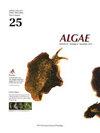Five phototrophic Scrippsiella species lacking mixotrophic ability and the extended prey spectrum of Scrippsiella acuminata (Thoracosphaerales, Dinophyceae)
IF 2.4
3区 生物学
Q1 MARINE & FRESHWATER BIOLOGY
引用次数: 0
Abstract
Mixotrophic dinoflagellates act as primary producers, prey, and predators in marine planktonic food webs, whereas exclusively autotrophic dinoflagellates are primary producers and prey. Species of the dinoflagellate genus Scrippsiella are commonly found in marine ecosystems and sometimes cause harmful red tides. Among the 28 formally described Scrippsiella species, S. acuminata has been found to be mixotrophic and two unidentified species have been found to be mixotrophic. To determine whether the other species in this genus are similarly mixotrophic, the mixotrophic ability of S. donghaiensis SDGJ1703, S. lachrymosa SLBS1703, S. masanensis SSMS0908, S. plana SSSH1009A, and S. ramonii VGO1053 was explored using 15 potential prey items, including 2-µm fluorescently labeled microspheres (FLM) and heterotrophic bacteria (FLB), the cyanobacterium Synechococcus sp., and various microalgal prey species. The ability of S. acuminata to feed on FLM and FLB was also investigated. We found that S. donghaiensis, S. lachrymosa, S. masanensis, S. plana, and S. ramonii did not feed on any potential prey tested in this study, indicating a lack of mixotrophy. However, S. acuminata fed on both FLM and FLB, confirming its mixotrophic ability. These results lowered the proportion of mixotrophic species relative to the total number of tested Scrippsiella species for mixotrophy from 100% to 29–38%. Owing to its mixotrophic ability, S. acuminata occupies an ecological niche that is distinct from that of S. donghaiensis, S. lachrymosa, S. masanensis, S. plana, and S. ramonii.五种缺乏混合营养能力的光营养斯克里普菌和渐尖斯克里普虫(胸磷虾目,藻科)的扩展捕食谱
混合营养甲藻是海洋浮游生物食物网中的主要生产者、猎物和捕食者,而完全自养甲藻是主要生产者和猎物。甲藻属斯克里普菌的物种常见于海洋生态系统中,有时会引起有害的赤潮。在28个正式描述的斯克里普菌物种中,尖锥藻被发现是混合营养的,两个未鉴定的物种被发现是混营养的。为了确定该属的其他物种是否具有类似的混合营养,使用15种潜在的猎物,包括2µm荧光标记微球(FLM)和异养细菌(FLB),即蓝细菌Synechococcus sp。,以及各种微藻猎物。同时,还研究了尖锐湿疣对FLM和FLB的取食能力。我们发现东海S.donghaiensis、拉克里莫萨S.lachrymosa、马桑S.masanensis、平坦S.plana和雷蒙尼S.ramonii没有以本研究中测试的任何潜在猎物为食,这表明它们缺乏混合营养。然而,尖锐湿疣同时以FLM和FLB为食,证实了其混合营养能力。这些结果将混合营养物种相对于测试的斯克里普菌混合营养物种总数的比例从100%降低到29-38%。由于其混合营养能力,渐尖S.acuminata占据的生态位不同于东海S.donghaiensis、拉克里莫萨S.lachrymosa、马桑S.masanensis、平坦S.plana和雷蒙尼S.ramonii。
本文章由计算机程序翻译,如有差异,请以英文原文为准。
求助全文
约1分钟内获得全文
求助全文
来源期刊

Algae
PLANT SCIENCES-
CiteScore
5.10
自引率
25.00%
发文量
18
期刊介绍:
ALGAE is published by the Korean Society of Phycology and provides prompt publication of original works on phycology. ALGAE publishes articles on all aspects of phylogenetics and taxonomy, ecology and population biology, physiology and biochemistry, cell and molecular biology, and biotechnology and applied phycology. Checklists or equivalent manu-scripts may be considered for publication only if they contribute original information on taxonomy (e.g., new combinations), ecology or biogeography of more than just local relevance. Contributions may take the form of Original Research Articles, Research Notes, Review Articles and Book Reviews.
 求助内容:
求助内容: 应助结果提醒方式:
应助结果提醒方式:


